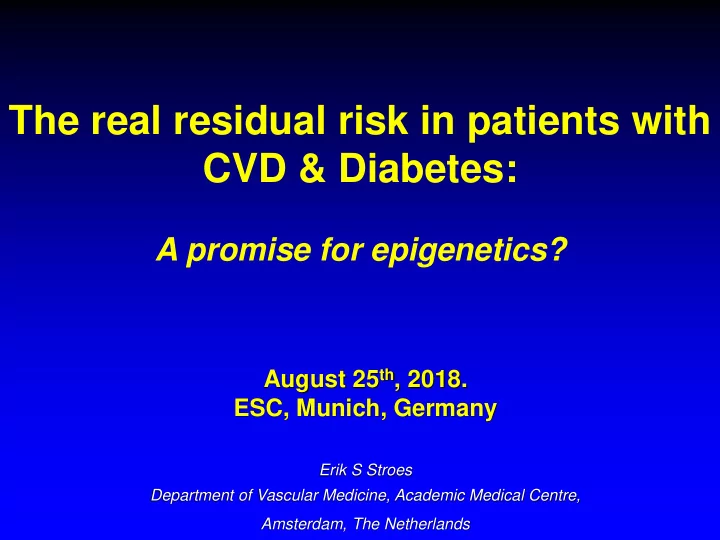

The real residual risk in patients with CVD & Diabetes: A promise for epigenetics? August 25 th , 2018. ESC, Munich, Germany Erik S Stroes Department of Vascular Medicine, Academic Medical Centre, Amsterdam, The Netherlands
Disclosures Speaker fees/ Ad-board fees have been paid to the institution for ES Stroes by: Amgen, Sanofi, Regeneron, Novartis, Astra-Zeneca, Akcea, Athera. Research grants / participation in clinical trials: Amgen, Sanofi, Astra-Zeneca, Akcea, Athera, Resverlogix Research funding: European Union (FP7, Horizon-2020, ERA-CVD), Dutch Heart Foundation (CVON)
Increased lifetime risk for CHD in diabetic patients Turin, Primary Care Diabetes 2017
Large impact on survival Large CV- morbidity / mortality increase Seshasai, N Engl J Med 2011
Residual risk after MI Prospective REACH registry Abtan, Clin Cardiol 2016
Benefit of intensive glucose control? Residual vascular risk minor reduction Giugliano, Endocrine 2018
LDL-c lowering potently reduces CV-risk Control 20 Five year risk of a major 22% relative risk reduction Statin with 1.0 mmol/L reduction vascular event, % 15 More statin 15% relative risk reduction with 0.5 mmol/L more reduction Statin-ezetimibe 34% relative risk reduction with 1.5 mmol/L reduction PCSK9 addition 10 33% relative risk reduction With 1.6 mmol/L reduction* 5 0 0.8 0 1 2 3 4 5 LDL cholesterol (mmol/L) * Extrapolated > 1yr treatment
Highest benefit in DM-patients Highest benefit in DM-patients Meta-analysis of statin-ezetimibe Meta-analysis of statin-ezetimibe Kang, EnM 2018 Kang, EnM 2018
High residual risk for DM-II patients Using high-dose statin therapy Atorvastatin 80 mg Eze 10 mg / Simva 40 mg Diabetes Diabetes Yes No Yes No 39.8% 26.1% 40.0% 30.2% *Cerebrovascular event, CHF with hospitalisation, CHD death, *Cardiovascular death, non-fatal MI, rehospitalisation for UA, MI, resuscitated cardiac arrest, coronary revascularisation and coronary revascularisation (occurring at least 30 days after documented angina randomisation) or stroke Shepherd et al. Diabetes Care 2006;29:1220 – 6 (TNT); CHD, coronary heart disease; CHF, congestive heart failure; Cannon et al, NEJM 2015;362:2387 – 97 and supplemental data (IMPROVE-IT). CV, cardiovascular; MI, myocardial infarction; UA, unstable angina.
Residual Risk Factors predicting MACE in CVD Patients with and without Diabetes Mellitus Lin, Scientific Reports 2017
High TG/low HDL- c ‘ marking ’ very high CV-risk in DM-II Lipid changes in DM-II Hermans, Curr Op Endo Diab Ob 2018
Multifactorial intervention needed Multifactorial intervention needed in DM-II in DM-II Ray , Lancet 2009 Ray , Lancet 2009
Is there more than lipids in CV-risk? CRP & residual risk in statin-treated patients: MESA study Wong, J Clin Lipidol 2017
Role of inflammation in CVD-event Lipids and Inflammation intertwined Foam Fatty Intermediate Atheroma Fibrous Complicated cell streak lesions plaque lesion/rupture Koenig W, Arterioscler Thromb Vasc Biol 2007;27:15 – 26.
Increased arterial wall inflammation in DM-II Bernelot-Moens , BMC Cardiovascular disorders 2016
Mechanistic pathways for increased vascular inflammation in DM-II Pechlivani, Frontiers Cardiov Med 2018
Hyperglycaemia increases MMP activity in smooth muscle cells Hyperglycemia: (i) High expression of MMP-1/9 (ii) increase in MCP1 (iii) Mediated by PKCa/NFkB signalling → high vulnerability of atherosclerotic plaque In DM? Macarie, J Cell Mol Med 2018
Will anti-inflammatory strategies benefit CV-patients with/without diabetes? Colchicine and methotrexate Methotrexate, CIRT study Colchicine, LoDoCo study Nidorf, JACC 2015 Renata Micha, Am J Cardiol 2011
Canakinumab Anti-Inflammatory Thrombosis Outcomes Study (CANTOS) Stable CAD (post MI) N = 10,061 On Statin, ACE/ARB, BB, ASA 39 Countries Persistent Elevation April 2011 - June 2017 of hsCRP (> 2 mg/L) 1490 Primary Events Randomized Randomized Randomized Randomized Canakinumab 150 mg Canakinumab 300 mg Canakinumab 50 mg Placebo SC q 3 months SC q 3 months* SC q 3 months SC q 3 months Primary CV Endpoint: Nonfatal MI, Nonfatal Stroke, Cardiovascular Death (MACE) Key Secondary CV Endpoint: MACE + Unstable Angina Requiring Unplanned Revascularization (MACE+) Ridker PM, et al. N Engl J Med . 2017
Drug Response to IL1-b ab (Canakinumab) on CRP, IL-6, and LDL-C Percent Change in hsCRP -100 -75 -50 -25 0 25 50 Percent Change in IL-6 -100 -75 -50 -25 0 25 50 Percent Change in LDL-C -100 -75 -50 -25 0 25 50 Canakinumab Canakinumab Canakinumab Placebo 50 mg 150 mg 300 mg Ridker PM et al. N Engl J Med . 2017;377:1119-31
CRP Tertiles Measured After the Initial Canakinumab dose Confirmed MACE by Tertiles of 3 Month hsCRP HR (95% CI) P ___________________________________________________________ 0.25 Placebo 1.0 (ref) (ref) On Treatment hsCRP: Top Tertile 0.99 (0.86,1.14) 0.93 On Treatment hsCRP: Middle Tertile 0.83 (0.72,0.96) 0.014 On Treatment hsCRP: Lowest Tertile 0.71 (0.61,0.82) <0.0001 0.20 Placebo Tertile 1 (hsCRP>2.6mg/L) Cumulative Incidence Tertile 2 (hsCRP >1.2-<2.6) 0.15 Tertile 3 (hsCRP <1.2mg/L) 0.10 0.05 MACE 29% reduction for those achieving lowest hsCRP tertile 17 % reduction for those achieving middle hsCRP tertile 1 % reduction for those achieving highest hsCRP tertile 0.00 0 1 2 3 4 5 Follow-up (years) No. at risk: Placebo 3182 3014 2853 2525 1215 200 Canakinumab: Top Tertile 2090 1983 1866 1632 789 139 Middle Tertile 2044 1947 1866 1660 821 146 Lowest Tertile 2218 2147 2056 1856 888 153 Ridker PM et al. N Engl J Med . 2017;377:1119-31
Benefit, with ‘ risks ’… Ridker, N Engl J Med 2017
Working towards ‘safer’ anti - inflammatory interventions Targeting immune-metabolism Inhibiting inducible glycolysis Targeted delivery of inhibitors of signalling cascades nanotherapy (rHDL, liposomes) CD40-TRAF signalling Targeting ‘ epigenetic ’ inflammatory amplification loops Epigenetic modulation and CAD-risk Trained immunity Li, Carmeliet, Science 2018 Lameijer, Duivenvoorden, Nature Biotechnology 2018 Nicchols, Am J Cardiov Drugs 2018; Leentjes, Riksen, Circ Res 2018;
Type 2 Diabetes Mellitus and CVD: Epigenetic Links ? Epigenetic mechanisms linking DM-II to CVD: Histone lysine modification / DNA methylation: High glucose: Hyper-insulinemia Reactive oxygen species Advanced glycation end-products De Rosa, Frontiers in Endocrinology 2018 R Sallerman, 2012
Summary High residual CV-risk in DM-II, despite LDL-C lowering DM-II characterized by pro-inflammatory state: Hyperinsulinemia, hyperglycemia Insulin resistance, ---- Anti-inflammatory interventions effective in CV-therapy New challenge : Identify effective and safe ‘anti -inflammatory ’ intervention able to reduce residual CV-burden in DM-II
Recommend
More recommend